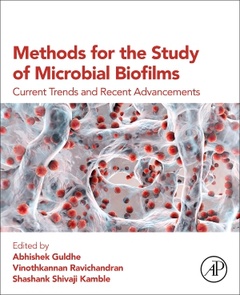Methods for the Study of Microbial Biofilms Current Trends and Recent Advancements
Coordonnateurs : Guldhe Abhishek, Ravichandran Vinothkannan, S Kamble Shashank

Methods for the study of microbial biofilms: Current Trends and Recent Advancements provides a detailed overview of the latest techniques for the study of biofilms. The book explores a wide range of methods for the characterization and study of cells within biofilms, including microscopy techniques, genomic approaches, transcriptomics, proteomic and proteogenomic tools. Computational and mathematical modelling are also covered. Chapters investigate the physiology of biofilm cells, gene expression pathways related to the formation, maturation and dispersion of biofilms, and molecular factors governing the biofilm formation and development, providing an overview of techniques that can be used at the cellular and molecular level. This book provides a broad overview of the biofilm field, along with the range of techniques that can be used to study and better understand them.
2. In silico methods to study biofilms
3. In vitro methods to study biofilms
4. Microscopic methods for biofilm analysis
5. In vivo models for biofilms6. Genomic approaches to study biofilms
7. Transcriptomics approaches: qPCR-based techniques
8. Transcriptomics approaches: Microarray and RNA sequencing-based techniques
9. Proteomics studies of biofilms
10. Metabolomics studies
11. Metagenomics/population studies for biofilms
12. Proteogenomic, a latest tool for simultaneous identification of microbial dynamics and proteins involved in biofilm formation
13. Mathematical tools to understand biofilms
Dr. Vinothkannan Ravichandran graduated from SASTRA University, Thanjavur, Tamil Nadu, India. He then joined IIT Madras as Research Associate. After that he joined Helmholtz institute of Biotechnology, Shandong University, China as a postdoctoral associate. His area of research is drug designing against quorum sensing pathways of multi drug resistant bacterial pathogens. With more than 6 years of postdoc experience, he joined Amity University Mumbai where he teaches various courses especially biochemistry and bioinformatics. He has contributed 27 publications in peer reviewed journals and completed a prestigious China Postdoctoral science foundation grant and Shandong University International Exchange Fellowship as well. He serves as reviewer in various national and international journals.
Dr. Shashank Kamble has expertise in the biology of infectious diseases with an emphasis on tuberculosis and a consistent academic background in microbiology. He holds a PhD in Biological Sciences from the CSIR-Institute of Genomics and Integrative Biology, New Delhi and is currently serving as the Assistant Professor at the Amity Institute of Biotechnology, Mumbai. He has 11 peer-reviewed international publications and has delivered invited talks in various academic institutions across the country. He has received research grants from national funding agencies and recently has received an award for his innovation o
- Explores in silico, in vitro, and in vivo analytical techniques for investigating biofilms
- Evaluates recent trends in omics approaches for biofilm characterization
- Facilitates understanding of the 3D organization of cells within biofilms, cell to cell communication, and the microbial dynamics within the biofilm community
- Looks at microbial biofilms across a range of disciplines, including those associated with medical devices, the food industry, and wastewater treatment
Date de parution : 12-2024
Ouvrage de 400 p.
Thème de Methods for the Study of Microbial Biofilms :
Mots-clés :
<; p>; Biofilm; in silico; in vitro; genomic; transcriptomic; proteomic; metabolomic; metagenomic; proteogenomic; microscopic<; /p>



